Exyzt: 12 years of machines to inhabit
Published 3 March 2015 by Ewen Chardronnet
Exyzt exhibit 12 years of explosive temporary architecture at Montpellier’s Tropisme festival. This best-of retrospective is also the final exclamation mark of a collective that is now spread across Europe.
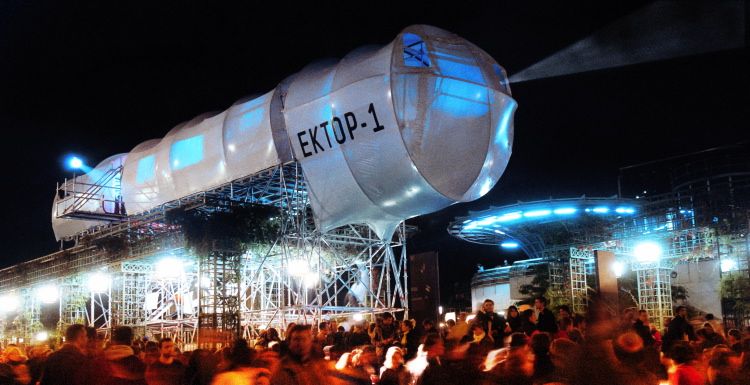
Montpellier, special report
The theme of the second three-week-long Tropisme festival is “machines to inhabit”. At La Panacée, Montpellier’s contemporary culture center, the usual spaces are repurposed as a concert hall, radio recording studio, children’s disco or nap room, printing room, etc. Exyzt occupy most of them.
In 2004, I ran into the Exyzt collective for the first time at Syndicat Potentiel in Strasbourg, their hometown, around Open Source City, a theoretical and practical workshop attended by hackers, makers, theorists and psychogeographers. Exyzt had just finished installing their final studies project “Architecture of the RAB” on an empty lot between the canal and the park of La Villette in Paris. Exyzt’s five founders—Gil Burban, Nicolas Henninger, Philippe Rizzotti, Pierre Schneider and François Wunschel—had just activated and inhabited this “urban RAB” for a month, building a modular space from scaffolding.
Fablab before its time
Exyzt’s vision was to develop fabrication methods that could be accessible to all. For Nicolas Henninger, president of the association, the underlying idea was fablabs using non-proprietary technologies: “The construction field is constantly being reframed by rules, by proprietary systems, by businesses that are certified to implement this or that technique. Of course, there are some fields where it’s important to employ specialists, but there are others where the users can do it themselves. This is what has always guided us.”

That same year, Exyzt used their construction protocol to build the European Architecture Students Assembly (EASA), a shelter for 450 students at Condition publique in Roubaix during Lille 2004. Students were offered cubicle kits to build their own shelters for the night, using simple prefabricated, modular scaffolding.
Exyzt share a studio at Point éphémère in Paris with Encore Heureux, another budding architecture collective, which is in charge of the venue for the big conference on climate change at Le Bourget at the end of the year. Exyzt is currently expanding its team with graphic artists and photographers (Christophe Goutes, Brice Pelleschi, Dagmar Dudinsky, Gonzague Lacombe, Studio Public, etc.) and finding its optimal form of expression somewhere between DIY construction, video-mapping, street-art esthetics, rich documentation and stop-motion films. The group occupies a studio baptized “Cyborg Castle” on Rue Hauteville in Paris, developing a style that architect and theorist Pedro Gadanho, currently architecture and design curator at MoMA in New York, qualifies as “performance architecture”.
“Der Berg” project, Exyzt, Palast der Republik, Berlin, 2005 :
“We did a lot of festivals and live performances,” admits Nicolas Henninger. “Beyond the impressive aspect of building quickly, what’s important is inspiring the desire to build together. We promote a shared human experience, which opens new horizons.”
“What’s important is not so much the result as the way it was constructed, the way the project lives, the joy of building, transforming a space.”Exyzt
“Anybody can do it,” Nicolas adds. “We want to convey this idea through its performative aspect, the idea of making, of empowerment, to enable people to act upon their own living conditions. Nicolas, who now lives in London, teaches at Central Saint Martins College of Art and Design, where just last week he organized “maker week”.
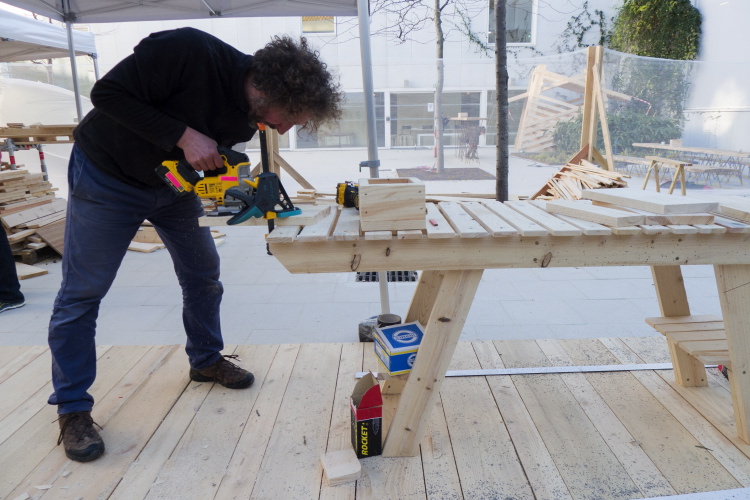
From 2004 to 2007, the year Latvia joined the European Union, Exyzt focused their attention on LabiChampi, a mushroom patch planted on the ruins of buildings from the Czarist empire, in the blocks of the former Soviet military port city of Karosta, Latvia, in partnership with the K@2 cultural center. Nicolas recalls their eye-opening “initiation” to “the importance of being one step ahead of the projects, solliciting situations, grabbing the beast by the horns and following an intuition.” In Karosta, a Russian ghetto just outside the city of Liepaja, K@2 developed a utopia that inspired a number of European artists and cultural players, but which closed after a few years due to political pressure from the city.
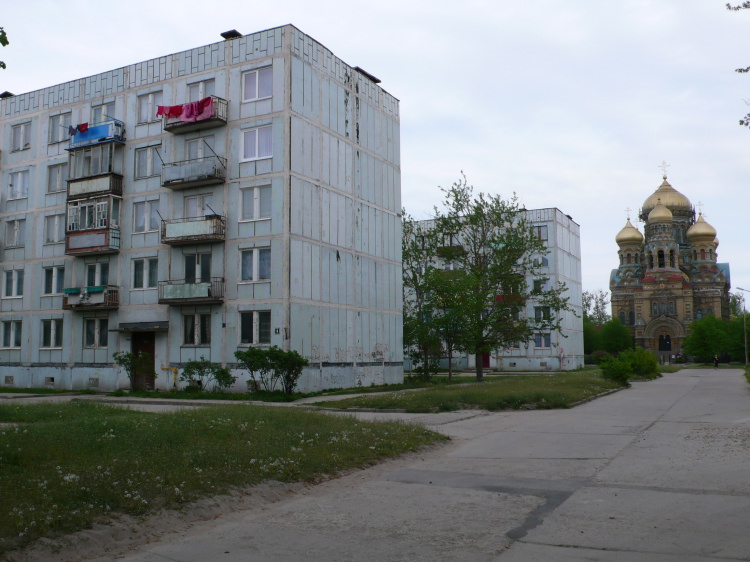
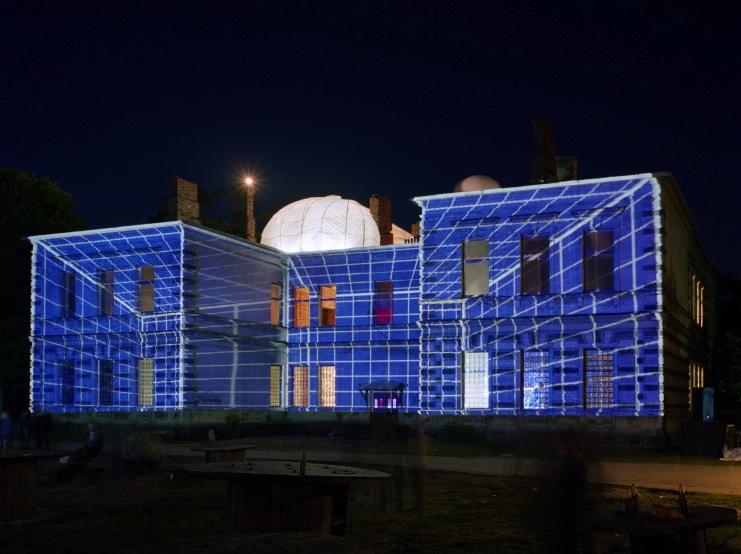
Utopia is also what guides Exyzt’s “machines to inhabit”. They reference multiple sources, such as the Abbey of Thelema, the place Rabelais described as without hierarchy or conflict, where you “do as you wish”, Charles Fourier’s phalanstery, a sort of cooperative hotel with shared spaces, Henri Lefebvre’s “architecture of delight”, and the Unitary Urbanism of the situationists, a “theory of employing all the arts and techniques that contribute to the integral construction of an environment dynamically linked to behavioral experiments”. This same utopia would be promoted at the 2006 Venice Architecture Biennial, under the direction of Patrick Bouchain, with the MetaVilla project, a machine to inhabit centered around the food and baths installed inside the French Pavilion.
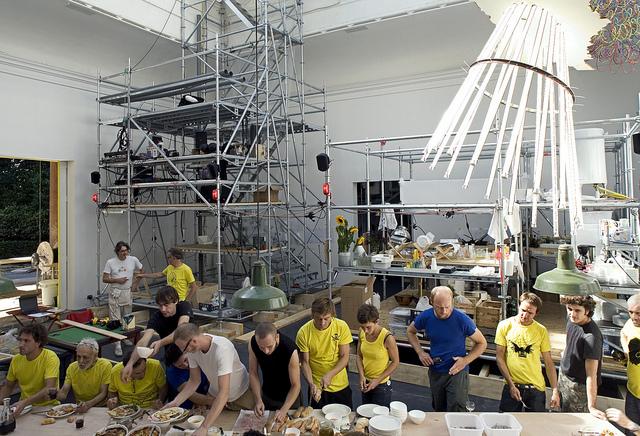
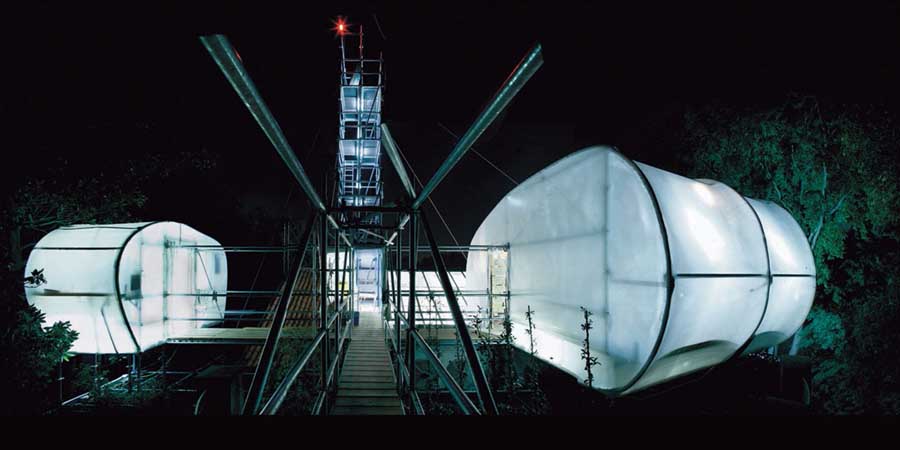
After the adventures of MetaVilla and LabiChampi, the collective dispersed. Pierre Schneider and François Wunschel founded 1024 Architecture to focus on architectural light and mapping projects, which would tour the world, from Square Cube for Étienne de Crecy at Tesseract in Bordeaux’s giant sub-marine base in 2014, to more perennial projects such as Fabrique de la Ville in Saint-Denis. Philippe Rizzotti exhibited his Situation Room at Storefront for Art & Architecture in New York. Gilles Burban continued the urban mushroom adventure with Polypop.
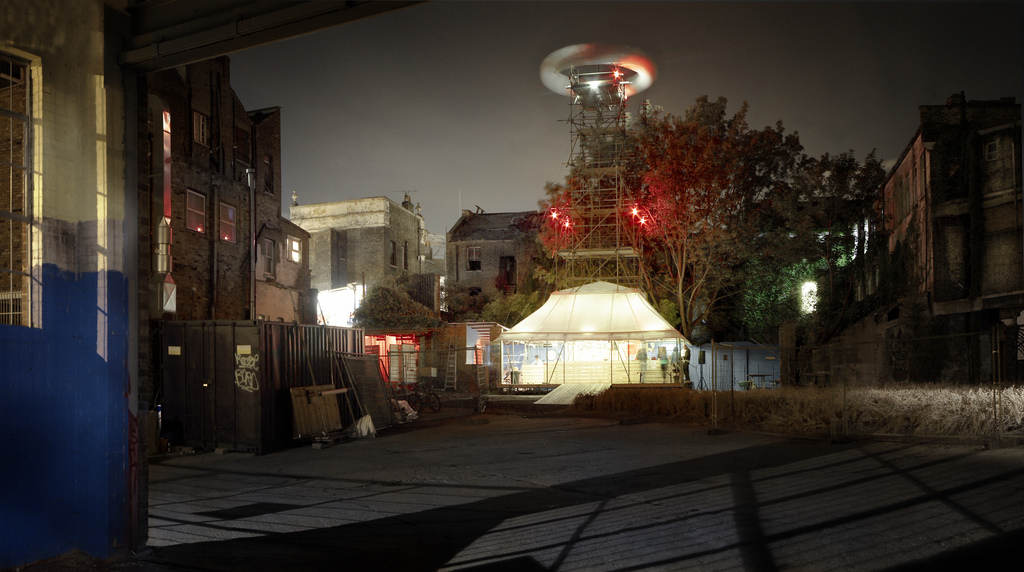
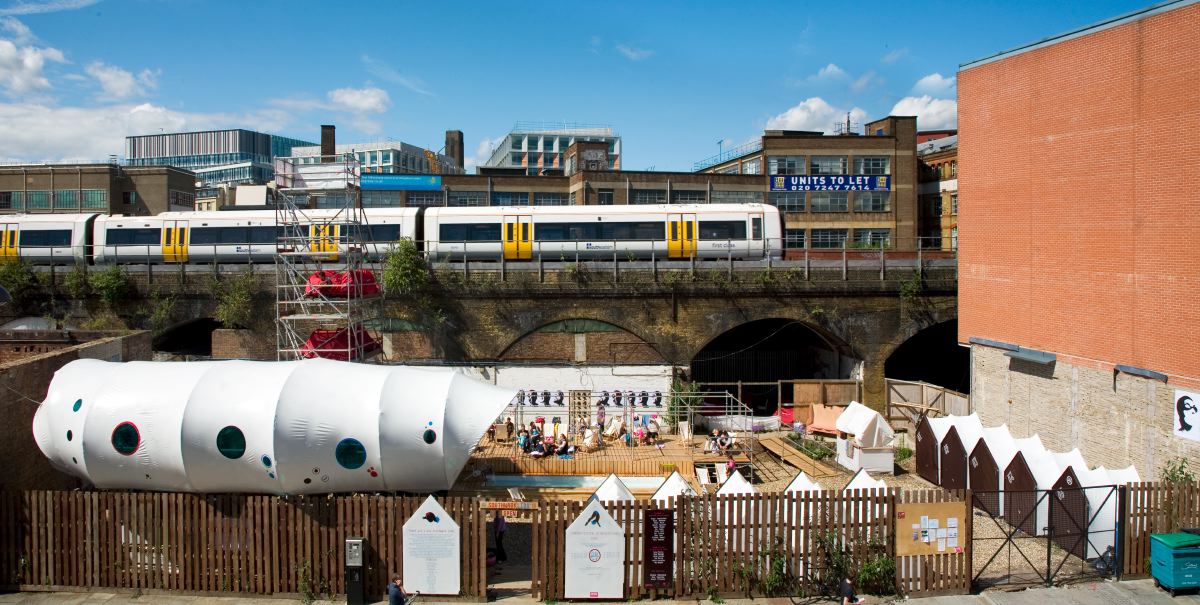
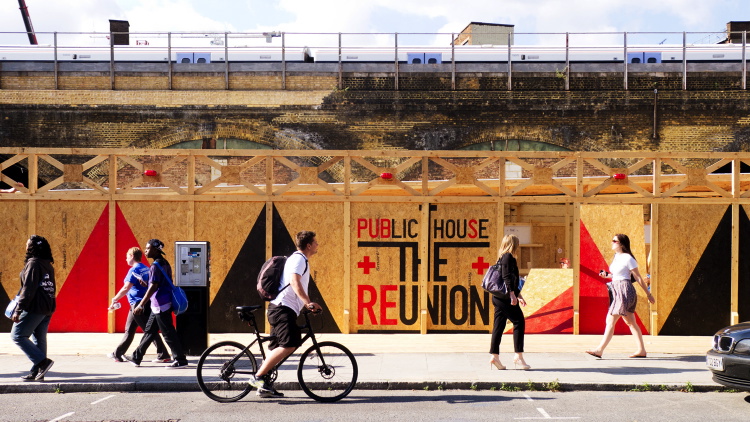
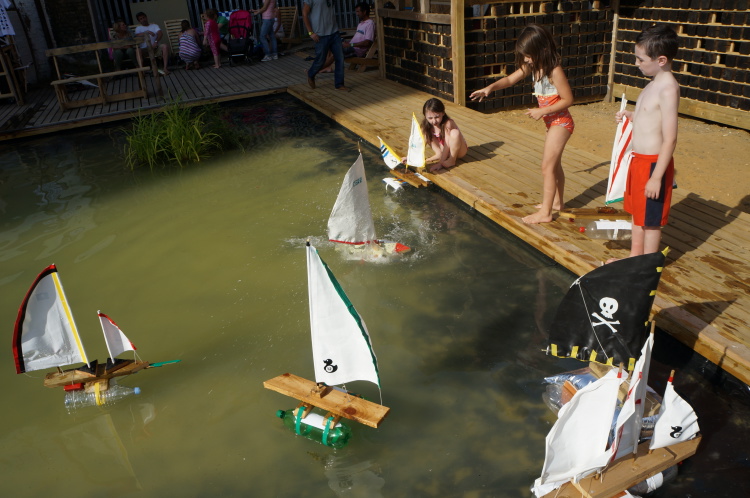
But Exyzt lives on: other builders and architects have since joined their adventure. Alexander Romer, Daya Bakker… It’s difficult to list them all, as Exyzt is picking up more and more people, operating in Poland, Germany, Portugal, Netherlands… But it’s in London that Exyzt is perfecting its protocol for cooperatively promoting seasonal constructions. It’s a way of reducing costs and rethinking social spaces, shared gardens, public baths, following a sustainable vision that takes into account limited investment in material. In 2013, Southwark Lido (2008), The Dalston Mill (2009), The Reunion (2012) and The Lake baths appeared on London’s Union Street.
“These projects are often cited by city governments in the UK as examples of temporary projects,” says Nicolas. “Other collectives such as Assemble Studio and Practice Architecture have since developed their own practice. Others based their projects on ours. The Ooze collective, whom we met at Evento festival in Bordeaux in 2011, is now building London’s first natural swimming pool, with water treatment by phytoremediation.”
Ephemeral and balanced architecture
The Exyzt “method” relies on balance: “Even if it’s temporary, we have to find the right balance, so that it’s not a waste of means. We owe a lot to Raf Salis, who brought back this DIY approach, this spirit of resilience. For marginalized young people, who live in neighborhoods without schools, this type of project allows them to learn how to organize themselves, to feel that they’re able to do so, to find motivation to work. This temporary action brings out the fun of building simple things. As with our water projects, you don’t have to build an olympic swimming pool. You can have different relationship with water, like Oasis in Vitrolles in 2013, where we reanimated a fountain, with games for children and mist sprayers, to create another, more playful relationship with the fountain. The project also had a role in public space, as it gave young people a job for three months.”
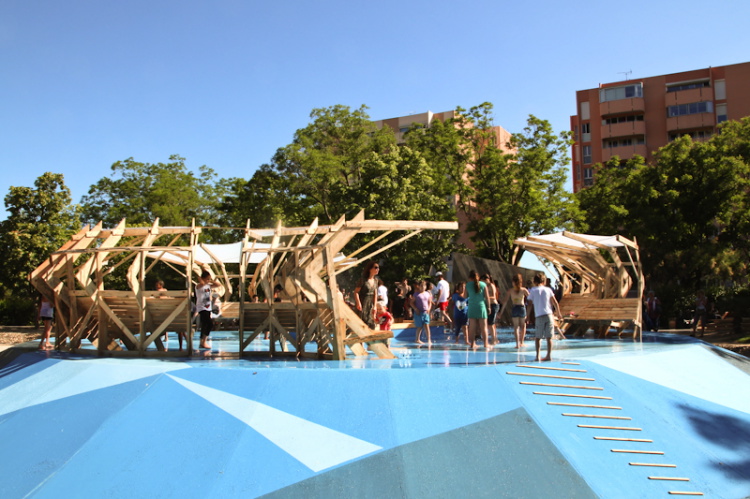
“Here at La Panacée, we already have everything we need,” says Nicolas. “We live at the art center, so that we can come with our kids, our family, our friends, appropriate the space. Living in the culture is important, even if the art centers are not our final stop.”
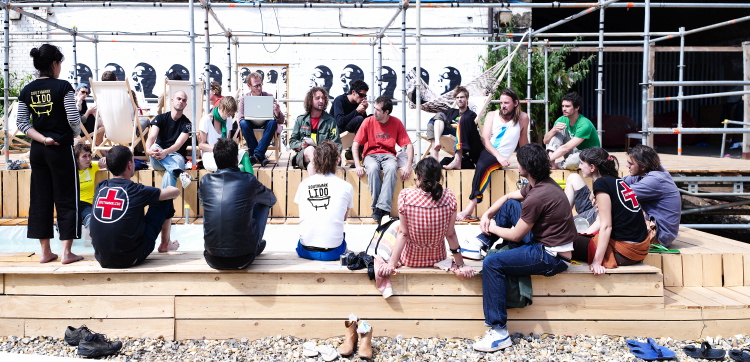
Ex-Exyzt continue to develop strategies for public space and temporary projects for empty lots, create local employment, training and other economies. They are also developing more structured protocols for more difficult situations and neighborhoods, “where people have even more of a need to regain confidence in themselves”.
Machine à habiter, through March 15, 2015 at La Panacée, Montpellier
